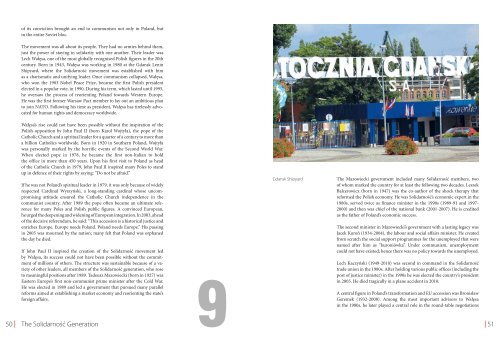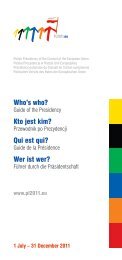„The Brighter Side of Europe” / Piotr Kaczyński
„The Brighter Side of Europe” / Piotr Kaczyński
„The Brighter Side of Europe” / Piotr Kaczyński
Create successful ePaper yourself
Turn your PDF publications into a flip-book with our unique Google optimized e-Paper software.
<strong>of</strong> its conviction brought an end to communism not only in Poland, but<br />
in the entire Soviet bloc.<br />
The movement was all about its people. They had no armies behind them,<br />
just the power <strong>of</strong> staying in solidarity with one another. Their leader was<br />
Lech Wałęsa, one <strong>of</strong> the most globally recognised Polish figures in the 20th<br />
century. Born in 1943, Wałęsa was working in 1980 at the Gdansk Lenin<br />
Shipyard, where the Solidarność movement was established with him<br />
as a charismatic and unifying leader. Once communism collapsed, Wałęsa,<br />
who won the 1983 Nobel Peace Prize, became the first Polish president<br />
elected in a popular vote, in 1990. During his term, which lasted until 1995,<br />
he oversaw the process <strong>of</strong> reorienting Poland towards Western Europe.<br />
He was the first former Warsaw Pact member to lay out an ambitious plan<br />
to join NATO. Following his time as president, Wałęsa has tirelessly advocated<br />
for human rights and democracy worldwide.<br />
Wałęsa’s rise could not have been possible without the inspiration <strong>of</strong> the<br />
Polish opposition by John Paul II (born Karol Wojtyła), the pope <strong>of</strong> the<br />
Catholic Church and a spiritual leader for a quarter <strong>of</strong> a century to more than<br />
a billion Catholics worldwide. Born in 1920 in Southern Poland, Wojtyła<br />
was personally marked by the horrific events <strong>of</strong> the Second World War.<br />
When elected pope in 1978, he became the first non-Italian to hold<br />
the <strong>of</strong>fice in more than 450 years. Upon his first visit to Poland as head<br />
<strong>of</strong> the Catholic Church in 1979, John Paul II inspired many Poles to stand<br />
up in defence <strong>of</strong> their rights by saying: “Do not be afraid.”<br />
If he was not Poland’s spiritual leader in 1979, it was only because <strong>of</strong> widely<br />
respected Cardinal Wyszyński, a long-standing cardinal whose uncompromising<br />
attitude ensured the Catholic Church independence in the<br />
communist country. After 1989 the pope <strong>of</strong>ten became an ultimate reference<br />
for many Poles and Polish public figures. A convinced European,<br />
he urged the deepening and widening <strong>of</strong> European integration. In 2003, ahead<br />
<strong>of</strong> the decisive referendum, he said: “This accession is a historical justice and<br />
enriches Europe. Europe needs Poland. Poland needs Europe.” His passing<br />
in 2005 was mourned by the nation; many felt that Poland was orphaned<br />
the day he died.<br />
If John Paul II inspired the creation <strong>of</strong> the Solidarność movement led<br />
by Wałęsa, its success could not have been possible without the commitment<br />
<strong>of</strong> millions <strong>of</strong> others. The structure was sustainable because <strong>of</strong> a variety<br />
<strong>of</strong> other leaders, all members <strong>of</strong> the Solidarność generation, who rose<br />
to meaningful positions after 1989. Tadeusz Mazowiecki (born in 1927) was<br />
Eastern Europe’s first non-communist prime minister after the Cold War.<br />
He was elected in 1989 and led a government that pursued many parallel<br />
reforms aimed at establishing a market economy and reorienting the state’s<br />
foreign affairs.<br />
9<br />
Gdansk Shipyard<br />
The Mazowiecki government included many Solidarność members, two<br />
<strong>of</strong> whom marked the country for at least the following two decades. Leszek<br />
Balcerowicz (born in 1947) was the co-author <strong>of</strong> the shock therapy that<br />
reformed the Polish economy. He was Solidarność’s economic expert in the<br />
1980s, served twice as finance minister in the 1990s (1989-91 and 1997-<br />
2000) and then was chief <strong>of</strong> the national bank (2001-2007). He is credited<br />
as the father <strong>of</strong> Poland’s economic success.<br />
The second minister in Mazowiecki’s government with a lasting legacy was<br />
Jacek Kuroń (1934-2004), the labour and social affairs minister. He created<br />
from scratch the social support programmes for the unemployed that were<br />
named after him as “kuroniówka”. Under communism, unemployment<br />
could not have existed; hence there was no policy towards the unemployed.<br />
Lech <strong>Kaczyński</strong> (1949-2010) was second in command in the Solidarność<br />
trade union in the 1980s. After holding various public <strong>of</strong>fices (including the<br />
post <strong>of</strong> justice minister) in the 1990s he was elected the country’s president<br />
in 2005. He died tragically in a plane accident in 2010.<br />
A central figure in Poland’s transformation and EU accession was Bronisław<br />
Geremek (1932-2008). Among the most important advisors to Wałęsa<br />
in the 1980s, he later played a central role in the round-table negotiations<br />
50 | The Solidarność Generation<br />
| 51



